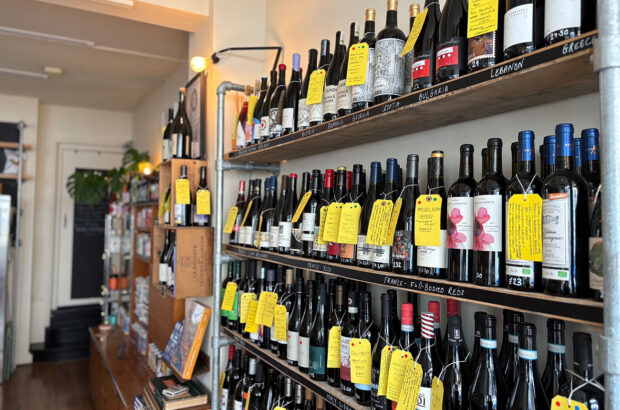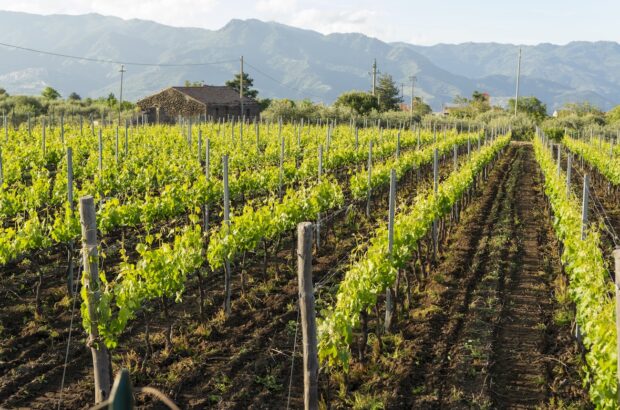Calvados is one of the ‘big three’ French brandies along with Cognac and Armagnac. Like its southern cousins, it matures in oak barrels and comes out bearing VS, VSOP and XO labels at two, four and six years, respectively. But where Cognac and Armagnac are based on grapes, Calvados begins life in the orchards of Normandy as apples and pears.
Its 300 producers make about 6 million bottles each year, half of which head overseas. Given this, it might seem odd that the UK doesn’t see more of it. Truth be told, le calva spent the last few decades in the doldrums. Now though its fortunes are on the up. Established brands such as Drouin and Coquerel are driving innovation, while new producers like Avallen and 30&40 have injected fresh energy.
Where is Calvados made?
Calvados is governed by three sets of overlapping AOC regulations. Each one has slightly different rules on the type of still that may be used and the proportion of apples and pears that can go into the mix.
The Calvados AOC is the main appellation and extends over all of Normandy. It is also the broadest, allowing apples and pears in any proportion, distilled in either pots or columns, and aged for at least two years in oak.
{"content":"PHA+PHN0cm9uZz5DYWx2YWRvcyBQYXlzIGTigJlBdWdlPC9zdHJvbmc+IGNvdmVycyBhbiBhcmVhIGp1c3QgZWFzdCBvZiBDYWVuLCBzdHJldGNoaW5nIGZyb20gRGVhdXZpbGxlIG9uIHRoZSBjb2FzdCB0byBhYm91dCAzMGttIHNvdXRoIG9mIExpc2lldXguIFByb2R1Y2VycyBoZXJlIG1heSB1c2UgYXQgbW9zdCAzMCUgcGVhcnMgYW5kIG11c3Qgb25seSB1c2UgY29wcGVyIHBvdHMgdG8gZGlzdGlsIHRoZWlyIHNwaXJpdC48L3A+CjxwPjxkaXYgY2xhc3M9ImFkLWNvbnRhaW5lciBhZC1jb250YWluZXItLW1vYmlsZSI+PGRpdiBpZD0icG9zdC1pbmxpbmUtMiIgY2xhc3M9ImlwYy1hZHZlcnQiPjwvZGl2PjwvZGl2PjwvcD4KPHA+PHN0cm9uZz5DYWx2YWRvcyBEb21mcm9udGFpczwvc3Ryb25nPiBsaWVzIGEgc21hbGwgZGlzdGFuY2Ugc291dGh3ZXN0IG9mIHRoaXMsIGNlbnRyZWQgYXJvdW5kIHRoZSB0b3duIG9mIERvbWZyb250LWVuLVBvaXJhaWUuIEhlcmUgdGhlIG1peCBtdXN0IGJlIGF0IGxlYXN0IDMwJSBwZWFycywgYW5kIGRpc3RpbGxlcnMgbXVzdCB1c2UgY29sdW1uIHN0aWxscyBoZWF0ZWQgYnkgYW4gb3BlbiBmaXJlLiBUaGV5IG11c3QgYWxzbyBtYXR1cmUgdGhlaXIgc3Bpcml0IGZvciBhdCBsZWFzdCB0aHJlZSB5ZWFycyByYXRoZXIgdGhhbiB0aGUgdXN1YWwgdHdvLjwvcD4KPGRpdiBpZD0iYXR0YWNobWVudF81MTQ5MTIiIHN0eWxlPSJ3aWR0aDogMTMxMHB4IiBjbGFzcz0id3AtY2FwdGlvbiBhbGlnbm5vbmUiPjxpbWcgZmV0Y2hwcmlvcml0eT0iaGlnaCIgZGVjb2Rpbmc9ImFzeW5jIiBhcmlhLWRlc2NyaWJlZGJ5PSJjYXB0aW9uLWF0dGFjaG1lbnQtNTE0OTEyIiBjbGFzcz0ibGF6eWxvYWQgYmx1ci11cCB3cC1pbWFnZS01MTQ5MTIgc2l6ZS1mdWxsIiBkYXRhLXByb2Nlc3NlZCBzcmM9Imh0dHBzOi8vd3d3LmRlY2FudGVyLmNvbS5tYXN0ZXIucHVibGljLmtleXN0b25lLXByb2QtZWtzLWV1dzEuZnV0dXJlcGxjLmVuZ2luZWVyaW5nL3dwLWNvbnRlbnQvdGhlbWVzL3NpbWJhLXRoZW1lL2Fzc2V0cy9pbWFnZXMvcGxhY2Vob2xkZXIucG5nIiBkYXRhLXNyYz0iaHR0cHM6Ly9rZXlhc3NldHMudGltZWluY3VrLm5ldC9pbnNwaXJld3AvbGl2ZS93cC1jb250ZW50L3VwbG9hZHMvc2l0ZXMvMzQvMjAyMy8xMC9DYWx2YWRvcy1EaXN0aWxsZXJ5LUdldHR5SW1hZ2VzLTEzNjg4OTAwNC5qcGciIGFsdD0iQmFycmVscyBpbiBhIGRpc3RpbGxlcnkiIHdpZHRoPSIxMzAwIiBoZWlnaHQ9Ijg2MCIgZGF0YS1zaXplcz0iYXV0byIgZGF0YS1zcmNzZXQ9Imh0dHBzOi8va2V5YXNzZXRzLnRpbWVpbmN1ay5uZXQvaW5zcGlyZXdwL2xpdmUvd3AtY29udGVudC91cGxvYWRzL3NpdGVzLzM0LzIwMjMvMTAvQ2FsdmFkb3MtRGlzdGlsbGVyeS1HZXR0eUltYWdlcy0xMzY4ODkwMDQuanBnIDEzMDB3LCBodHRwczovL2tleWFzc2V0cy50aW1laW5jdWsubmV0L2luc3BpcmV3cC9saXZlL3dwLWNvbnRlbnQvdXBsb2Fkcy9zaXRlcy8zNC8yMDIzLzEwL0NhbHZhZG9zLURpc3RpbGxlcnktR2V0dHlJbWFnZXMtMTM2ODg5MDA0LTMwMHgxOTguanBnIDMwMHcsIGh0dHBzOi8va2V5YXNzZXRzLnRpbWVpbmN1ay5uZXQvaW5zcGlyZXdwL2xpdmUvd3AtY29udGVudC91cGxvYWRzL3NpdGVzLzM0LzIwMjMvMTAvQ2FsdmFkb3MtRGlzdGlsbGVyeS1HZXR0eUltYWdlcy0xMzY4ODkwMDQtNjMweDQxNy5qcGcgNjMwdywgaHR0cHM6Ly9rZXlhc3NldHMudGltZWluY3VrLm5ldC9pbnNwaXJld3AvbGl2ZS93cC1jb250ZW50L3VwbG9hZHMvc2l0ZXMvMzQvMjAyMy8xMC9DYWx2YWRvcy1EaXN0aWxsZXJ5LUdldHR5SW1hZ2VzLTEzNjg4OTAwNC0xMzV4ODkuanBnIDEzNXcsIGh0dHBzOi8va2V5YXNzZXRzLnRpbWVpbmN1ay5uZXQvaW5zcGlyZXdwL2xpdmUvd3AtY29udGVudC91cGxvYWRzL3NpdGVzLzM0LzIwMjMvMTAvQ2FsdmFkb3MtRGlzdGlsbGVyeS1HZXR0eUltYWdlcy0xMzY4ODkwMDQtMzIweDIxMi5qcGcgMzIwdywgaHR0cHM6Ly9rZXlhc3NldHMudGltZWluY3VrLm5ldC9pbnNwaXJld3AvbGl2ZS93cC1jb250ZW50L3VwbG9hZHMvc2l0ZXMvMzQvMjAyMy8xMC9DYWx2YWRvcy1EaXN0aWxsZXJ5LUdldHR5SW1hZ2VzLTEzNjg4OTAwNC02MjB4NDEwLmpwZyA2MjB3LCBodHRwczovL2tleWFzc2V0cy50aW1laW5jdWsubmV0L2luc3BpcmV3cC9saXZlL3dwLWNvbnRlbnQvdXBsb2Fkcy9zaXRlcy8zNC8yMDIzLzEwL0NhbHZhZG9zLURpc3RpbGxlcnktR2V0dHlJbWFnZXMtMTM2ODg5MDA0LTkyMHg2MDkuanBnIDkyMHcsIGh0dHBzOi8va2V5YXNzZXRzLnRpbWVpbmN1ay5uZXQvaW5zcGlyZXdwL2xpdmUvd3AtY29udGVudC91cGxvYWRzL3NpdGVzLzM0LzIwMjMvMTAvQ2FsdmFkb3MtRGlzdGlsbGVyeS1HZXR0eUltYWdlcy0xMzY4ODkwMDQtMTIyMHg4MDcuanBnIDEyMjB3IiBzaXplcz0iKG1heC13aWR0aDogMTMwMHB4KSAxMDB2dywgMTMwMHB4IiAvPjxwIGlkPSJjYXB0aW9uLWF0dGFjaG1lbnQtNTE0OTEyIiBjbGFzcz0id3AtY2FwdGlvbi10ZXh0Ij5CYXJyZWxzIHJlc3RpbmcgaW4gYSBDYWx2YWRvcyBkaXN0aWxsZXJ5IGluIE5vcm1hbmR5LiBDcmVkaXQ6IE1hZHppYTcxIC8gRSsgdmlhIEdldHR5IEltYWdlczwvcD48L2Rpdj4KPGgzPldoYXQgZG9lcyBDYWx2YWRvcyB0YXN0ZSBsaWtlPzwvaDM+CjxwPkluIGEgd29yZDogZmFtaWxpYXIuIFdlIGFsbCBrbm93IGFwcGxlcy4gVGhpcyBtYWtlcyBDYWx2YWRvcyB2ZXJ5IGFwcHJvYWNoYWJsZSwgZXNwZWNpYWxseSBmb3IgZHJpbmtlcnMgbmV3IHRvIHNwaXJpdHMgYWdlZCBpbiB3b29kLiBUaGUgb2FrIGJhcnJlbHMgYWRkIGxheWVycyBvZiB2YW5pbGxhIGFuZCBiYWtpbmcgc3BpY2VzLiBBcHBsZSBjcnVtYmxlIGFuZCBjdXN0YXJkLCBhbnlvbmU\/IEFkZGluZyBpbiBwZWFycyBicmluZ3MgYSBsaWdodCBhbmQgZmxvcmFsIGNoYXJhY3RlcjsgaWYgeW914oCZdmUgZXZlciBjb21wYXJlZCBwZXJyeSB0byBjaWRlciB0aGlzIHNob3VsZCBiZSBmYW1pbGlhciBncm91bmQuPC9wPgo8ZGl2IGNsYXNzPSJhZC1jb250YWluZXIgYWQtY29udGFpbmVyLS1tb2JpbGUiPjxkaXYgaWQ9InBvc3QtaW5saW5lLTMiIGNsYXNzPSJpcGMtYWR2ZXJ0Ij48L2Rpdj48L2Rpdj4KPHA+WW91bmdlciBDYWx2YWRvc2VzIHRlbmQgdG8gYmUgbGlnaHRlciBhbmQgbW9yZSBmcnVpdC1mb3J3YXJkLiBUaGV5IG9mdGVuIGRpc3BsYXkgZmxvcmFsIGFuZCBmcnVpdHkgYXJvbWFzIGZyb20gdGhlaXIgZmVybWVudGF0aW9uIHRoYXQgY29tcGxlbWVudCB0aGUgZmxhdm91cnMgb2YgdGhlIGZydWl0LiBUaGUgaW5mbHVlbmNlIG9mIHRoZSBvYWsgaXMsIGF0IHRoaXMgc3RhZ2UsIG1vcmUgb2YgYSBnZW50bGUgYmFja2dyb3VuZCBkZXB0aC4gVGhpbmsgYnJpb2NoZSBhbmQgZ2xhemVkIHBhc3RyaWVzIGZpbGxlZCB3aXRoIGNyw6htZSBww6J0aXNzacOocmUuPC9wPgo8cD5XaXRoIGFnZSB0aGUgZnJ1aXQgZGV2ZWxvcHMsIGNoYW5naW5nIGZyb20gZnJlc2ggdG8gc29tZXRoaW5nIG1vcmUgbGlrZSBiYWtlZCBvciBwb2FjaGVkIGFwcGxlcyBhbmQgcGVhcnMuIFRhcnRlIHRhdGluIHNwcmluZ3MgdG8gbWluZCBub3cuIFRoZSBmbGF2b3VycyBmcm9tIHRoZSBiYXJyZWxzIHVzdWFsbHkgZ3JvdyBzdHJvbmdlciBhbmQgaW4gc29tZSBzcGlyaXRzIGEgdGFubmljIGRyeW5lc3MgY2FuIGRldmVsb3Agb24gdGhlIGZpbmlzaC48L3A+CjxkaXYgY2xhc3M9ImFkLWNvbnRhaW5lciBhZC1jb250YWluZXItLW1vYmlsZSI+PGRpdiBpZD0icG9zdC1pbmxpbmUtNCIgY2xhc3M9ImlwYy1hZHZlcnQiPjwvZGl2PjwvZGl2Pgo8cD48aW1nIGRlY29kaW5nPSJhc3luYyIgY2xhc3M9Imxhenlsb2FkIGJsdXItdXAgYWxpZ25ub25lIHNpemUtbWVkaXVtIHdwLWltYWdlLTQ4MzYxMSIgZGF0YS1wcm9jZXNzZWQgc3JjPSJodHRwczovL3d3dy5kZWNhbnRlci5jb20ubWFzdGVyLnB1YmxpYy5rZXlzdG9uZS1wcm9kLWVrcy1ldXcxLmZ1dHVyZXBsYy5lbmdpbmVlcmluZy93cC1jb250ZW50L3RoZW1lcy9zaW1iYS10aGVtZS9hc3NldHMvaW1hZ2VzL3BsYWNlaG9sZGVyLnBuZyIgZGF0YS1zcmM9Imh0dHBzOi8va2V5YXNzZXRzLnRpbWVpbmN1ay5uZXQvaW5zcGlyZXdwL2xpdmUvd3AtY29udGVudC91cGxvYWRzL3NpdGVzLzM0LzIwMjIvMDcvQXZhbGxlbi1DYWx2YWRvcy1IaWdoYmFsbC0zMDB4MTk4LmpwZyIgYWx0PSJBIGJvdHRsZSBvZiBDYWx2YWRvcyBhbmQgYSIgd2lkdGg9IjMwMCIgaGVpZ2h0PSIxOTgiIGRhdGEtc2l6ZXM9ImF1dG8iIGRhdGEtc3Jjc2V0PSJodHRwczovL2tleWFzc2V0cy50aW1laW5jdWsubmV0L2luc3BpcmV3cC9saXZlL3dwLWNvbnRlbnQvdXBsb2Fkcy9zaXRlcy8zNC8yMDIyLzA3L0F2YWxsZW4tQ2FsdmFkb3MtSGlnaGJhbGwtMzAweDE5OC5qcGcgMzAwdywgaHR0cHM6Ly9rZXlhc3NldHMudGltZWluY3VrLm5ldC9pbnNwaXJld3AvbGl2ZS93cC1jb250ZW50L3VwbG9hZHMvc2l0ZXMvMzQvMjAyMi8wNy9BdmFsbGVuLUNhbHZhZG9zLUhpZ2hiYWxsLTYzMHg0MTcuanBnIDYzMHcsIGh0dHBzOi8va2V5YXNzZXRzLnRpbWVpbmN1ay5uZXQvaW5zcGlyZXdwL2xpdmUvd3AtY29udGVudC91cGxvYWRzL3NpdGVzLzM0LzIwMjIvMDcvQXZhbGxlbi1DYWx2YWRvcy1IaWdoYmFsbC0xMzV4ODkuanBnIDEzNXcsIGh0dHBzOi8va2V5YXNzZXRzLnRpbWVpbmN1ay5uZXQvaW5zcGlyZXdwL2xpdmUvd3AtY29udGVudC91cGxvYWRzL3NpdGVzLzM0LzIwMjIvMDcvQXZhbGxlbi1DYWx2YWRvcy1IaWdoYmFsbC0zMjB4MjEyLmpwZyAzMjB3LCBodHRwczovL2tleWFzc2V0cy50aW1laW5jdWsubmV0L2luc3BpcmV3cC9saXZlL3dwLWNvbnRlbnQvdXBsb2Fkcy9zaXRlcy8zNC8yMDIyLzA3L0F2YWxsZW4tQ2FsdmFkb3MtSGlnaGJhbGwtNjIweDQxMC5qcGcgNjIwdywgaHR0cHM6Ly9rZXlhc3NldHMudGltZWluY3VrLm5ldC9pbnNwaXJld3AvbGl2ZS93cC1jb250ZW50L3VwbG9hZHMvc2l0ZXMvMzQvMjAyMi8wNy9BdmFsbGVuLUNhbHZhZG9zLUhpZ2hiYWxsLTkyMHg2MDkuanBnIDkyMHcsIGh0dHBzOi8va2V5YXNzZXRzLnRpbWVpbmN1ay5uZXQvaW5zcGlyZXdwL2xpdmUvd3AtY29udGVudC91cGxvYWRzL3NpdGVzLzM0LzIwMjIvMDcvQXZhbGxlbi1DYWx2YWRvcy1IaWdoYmFsbC0xMjIweDgwNy5qcGcgMTIyMHcsIGh0dHBzOi8va2V5YXNzZXRzLnRpbWVpbmN1ay5uZXQvaW5zcGlyZXdwL2xpdmUvd3AtY29udGVudC91cGxvYWRzL3NpdGVzLzM0LzIwMjIvMDcvQXZhbGxlbi1DYWx2YWRvcy1IaWdoYmFsbC5qcGcgMTMwMHciIHNpemVzPSIobWF4LXdpZHRoOiAzMDBweCkgMTAwdncsIDMwMHB4IiAvPjwvcD4KPGgzPkhvdyB0byBkcmluayBDYWx2YWRvczwvaDM+CjxwPkZvciBhIGxvbmcgdGltZSBDYWx2YWRvcyB3YXMgYWxsLWJ1dCBzeW5vbnltb3VzIHdpdGggPGVtPmxlIHRyb3UgTm9ybWFuZDwvZW0+LCB3aGljaCBzYXcgaXQgc3dpZ2dlZCBuZWF0IGFzIGEgZGlnZXN0aWYgYWZ0ZXIgYSBtZWFsIOKAkyBvciBldmVuIGJldHdlZW4gY291cnNlcyBpZiB0YWJsZSBhbmQgZGluZXJzIGFsaWtlIHdlcmUgZXNwZWNpYWxseSBsYWRlbiB3aXRoIGZvb2QuIEl0cyBvdGhlciBtYWluIHJvbGUgd2FzIGFzIGEgZm9ydGlmeWluZyBwaWNrLW1lLXVwIGdsdWdnZWQgaW50byBob3QgY29mZmVlIG9uIGEgY29sZCwgZGFtcCBtb3JuaW5nLjwvcD4KPGRpdiBjbGFzcz0iYWQtY29udGFpbmVyIGFkLWNvbnRhaW5lci0tbW9iaWxlIj48ZGl2IGlkPSJwb3N0LWlubGluZS01IiBjbGFzcz0iaXBjLWFkdmVydCI+PC9kaXY+PC9kaXY+CjxwPk5vd2FkYXlzIHlvdeKAmXJlIG1vcmUgbGlrZWx5IHRvIHNlZSA8ZW0+bGUgY2Fmw6kgY2FsdmE8L2VtPiByZWludGVycHJldGVkIGFzIGEgcmlmZiBvbiB0aGUgPGEgaHJlZj0iaHR0cHM6Ly93d3cuZGVjYW50ZXIuY29tLm1hc3Rlci5wdWJsaWMua2V5c3RvbmUtcHJvZC1la3MtZXV3MS5mdXR1cmVwbGMuZW5naW5lZXJpbmcubWFzdGVyLnB1YmxpYy5rZXlzdG9uZS1wcm9kLWVrcy1ldXcxLmZ1dHVyZXBsYy5lbmdpbmVlcmluZy9zcGlyaXRzL2Jlc3Qtdm9ka2FzLWZvci10aGUtcGVyZmVjdC1lc3ByZXNzby1tYXJ0aW5pLTQ3MTk5MC8iIHRhcmdldD0iX2JsYW5rIiByZWw9Im5vb3BlbmVyIG5vcmVmZXJyZXIiPjxzdHJvbmc+RXNwcmVzc28gTWFydGluaTwvc3Ryb25nPjwvYT4sIGFzIENhbHZhZG9zIGVuam95cyBhIHJlc3VyZ2VuY2UgcG93ZXJpbmcgY29ja3RhaWxzLiBJdCBjYW4gYWxzbyBiZSBtaXhlZCBpbnRvIGxvbmcsIHJlZnJlc2hpbmcgYXBwbGUgc3ByaXR6ZXM7IHlvdW5nZXIsIGxpZ2h0ZXIgQ2FsdmFkb3NlcyBwZXJmb3JtIGVzcGVjaWFsbHkgd2VsbCBpbiB0aGlzIG1vZGUuPC9wPgo8cD5Gb3IgYW4gPGEgaHJlZj0iaHR0cHM6Ly93d3cuZGVjYW50ZXIuY29tLm1hc3Rlci5wdWJsaWMua2V5c3RvbmUtcHJvZC1la3MtZXV3MS5mdXR1cmVwbGMuZW5naW5lZXJpbmcubWFzdGVyLnB1YmxpYy5rZXlzdG9uZS1wcm9kLWVrcy1ldXcxLmZ1dHVyZXBsYy5lbmdpbmVlcmluZy9zcGlyaXRzL2Vhc3ktYXV0dW1uLWNvY2t0YWlscy10by1tYWtlLWF0LWhvbWUtNDg3NjIyLyIgdGFyZ2V0PSJfYmxhbmsiIHJlbD0ibm9vcGVuZXIgbm9yZWZlcnJlciI+PHN0cm9uZz5hdXR1bW5hbCBjb2NrdGFpbDwvc3Ryb25nPjwvYT4gdG8gY2VsZWJyYXRlIHRoZSBhcHBsZSBoYXJ2ZXN0LCBzdGlyIGVxdWFsIHBhcnRzIHlvdW5nIENhbHZhZG9zIGFuZCBzd2VldCB2ZXJtb3V0aCBvdmVyIGljZSB3aXRoIGEgY291cGxlIG9mIGRhc2hlcyBvZiBBbmdvc3R1cmEgQml0dGVycywgdGhlbiBzdHJhaW4gaW50byBhIGNoaWxsZWQgY291cGUgYW5kIGdhcm5pc2ggd2l0aCBhIG1hcmFzY2hpbm8gY2hlcnJ5LiBTb3VuZHMgbGlrZSBhIDxhIGhyZWY9Imh0dHBzOi8vd3d3LmRlY2FudGVyLmNvbS5tYXN0ZXIucHVibGljLmtleXN0b25lLXByb2QtZWtzLWV1dzEuZnV0dXJlcGxjLmVuZ2luZWVyaW5nLm1hc3Rlci5wdWJsaWMua2V5c3RvbmUtcHJvZC1la3MtZXV3MS5mdXR1cmVwbGMuZW5naW5lZXJpbmcvc3Bpcml0cy9iZXN0LXdoaXNrZXlzLWZvci1hLW1hbmhhdHRhbi00NDk3MjMvIiB0YXJnZXQ9Il9ibGFuayIgcmVsPSJub29wZW5lciBub3JlZmVycmVyIj48c3Ryb25nPk1hbmhhdHRhbjwvc3Ryb25nPjwvYT4sIGJ1dCBtYXliZSBpdOKAmXMgbW9yZSBvZiBhIEJpZyBBcHBsZT88L3A+CjxoMz5DYWx2YWRvcyB0byB0cnk8L2gzPgo8aHI+CjxoMz48c3Ryb25nPjMwJmFtcDs0MCBFeHRyYSBPbGQgMTAgWWVhciBPbGQgQ2FsdmFkb3M8L3N0cm9uZz48L2gzPgo8cD5JbmRlcGVuZGVudCBib3R0bGVyIDMwJmFtcDs0MCBoYXMgYSBzaW5nbGUgY2FzayByYW5nZSBhbmQgYSByYW5nZSBvZiBibGVuZHMuIFRoaXMgaXMgYSBibGVuZCBvZiBmb3VyIENhbHZhZG9zZXMgZnJvbSB0aHJlZSBwcm9kdWNlcnMsIGFnZWQgYmV0d2VlbiAxMCBhbmQgMjggeWVhcnMuIEV4cGVjdCBmcnVpdHkgYXBwbGUgYW5kIHF1aW5jZSBhcm9tYXMgd2l0aCBiYWtlZCBhcHBsZXMsIHN0ZXdlZCBwZWFjaGVzIGFuZCBidXR0ZXJ5IGZ1ZGdlIG9uIHRoZSBwYWxhdGUuIDxzdHJvbmc+QWxjb2hvbCA0MiU8L3N0cm9uZz48L3A+Cjxocj4KPGgzPjxzdHJvbmc+QXZhbGxlbiBDYWx2YWRvczwvc3Ryb25nPjwvaDM+CjxwPlRoaXMgaXMgYSB5b3VuZyBDYWx2YWRvcyBhbmQgdmVyeSBhcHByb2FjaGFibGUuIFlvdeKAmWxsIGZpbmQgbm90ZXMgb2YgY3Jpc3AsIGxpZ2h0IGFwcGxlcyBvdmVybGFpZCB3aXRoIGZsb3JhbCBub3Rlcy4gSXTigJlzIGdyZWF0IGZvciBtaXhpbmcgaW50byBhIGNvY2t0YWlsIG9yIHNwcml0ei4gRXZlcnkgYm90dGxlIHNvbGQgcmVtb3ZlcyAyLjcza2cgbyBjYXJib24gZGlveGlkZSBmcm9tIHRoZSBhdG1vc3BoZXJlIGFuZCBwYXJ0IG9mIHRoZSBwcm9maXRzIGZ1bmQgY2hhcml0aWVzIHRvIHN1cHBvcnQgYmVlcy4gPHN0cm9uZz5BbGMgNDAlPC9zdHJvbmc+PC9wPgo8aHI+CjxoMz48c3Ryb25nPkNocmlzdGlhbiBEcm91aW4gQ2Fyb25pIEFuZ2VscyBDYWx2YWRvczwvc3Ryb25nPjwvaDM+CjxwPlRoaXMgQ2FsdmFkb3MgaXMgbWF0dXJlZCBpbiBvYWsgZm9yIDE3IHllYXJzIGJlZm9yZSBzb2FraW5nIGluIGZvcm1lciBDYXJvbmkgcnVtIGNhc2tzIGZvciBhIGZ1cnRoZXIgZWlnaHQgbW9udGhzLiBJdCBoYXMgY29tcGxleCBhcm9tYXMgb2Ygcm9hc3RlZCBhcHBsZSwgZHJpZWQgYXByaWNvdCwgbGVhdGhlciwgcGV0cm9sZXVtIGFuZCBicm93biBzdWdhci4gVG9hc3RlZCBhbmQgc21va3kgYmFrZWQgYXBwbGUgam9pbnMgb24gdGhlIHBhbGF0ZS4gPHN0cm9uZz5BbGMgNDguOCU8L3N0cm9uZz48L3A+Cjxocj4KPGgzPjxzdHJvbmc+RGlkaWVyIExlbW9ydG9uIDMwIFllYXIgT2xkIERvbWZyb250YWlzIENhbHZhZG9zPC9zdHJvbmc+PC9oMz4KPHA+RG9tZnJvbnRhaXMgQ2FsdmFkb3MgaXMgaGFyZGVyIHRvIGZpbmQgaW4gdGhlIFVLLCBidXQgdGhhbmtmdWxseSB0aGlzIGlzIGEgZmluZSBleGFtcGxlIGFuZCBnb29kIHZhbHVlIHRvby4gUGVhcnMgbWFrZSB1cCA3MCUgb2YgdGhlIG1peCwgc28gdGhleSBydWxlIHRoZSBmbGF2b3VyIHJvb3N0LiBFeHBlY3QgZWxlZ2FudCBwb2FjaGVkIHBlYXIgYW5kIHRvZmZlZSBhcHBsZSwgaG9uZXksIGNhcmFtZWwsIHZhbmlsbGEgYW5kIHBlcHBlcnkgc3BpY2UuIDxzdHJvbmc+QWxjIDQwJTwvc3Ryb25nPjwvcD4KPGhyPgo8aDM+PHN0cm9uZz5NaWNoZWwgSHVhcmQgMjAwMyBDYWx2YWRvczwvc3Ryb25nPjwvaDM+CjxwPlRoaXMgd2VsbC1yZWdhcmRlZCBmYW1pbHkgcHJvZHVjZXIsIG5vdyBydW4gYnkgaXRzIHNldmVudGggZ2VuZXJhdGlvbiwgbWFrZXMgbWFpbmx5IHZpbnRhZ2VzIHJhdGhlciB0aGFuIHRoZSB1c3VhbCBub24tdmludGFnZSBibGVuZHMuIFRoaXMgbWVhbnMgZWFjaCBib3R0bGUgaXMgbWFkZSBmcm9tIGZydWl0IGdyb3duIGFuZCBkaXN0aWxsZWQgaW4gdGhlIHllYXIgc2hvd24gb24gdGhlIGxhYmVsLiBUaGlzIG9uZSwgZGlzdGlsbGVkIGluIDIwMDMsIGRpc3BsYXlzIGxpZ2h0IG5vdGVzIG9mIGdyZWVuIGFwcGxlLCBjYXJhbWVsIGFuZCBudXRtZWcuIDxzdHJvbmc+QWxjIDQwJTwvc3Ryb25nPjwvcD4KPGhyPgo8aDM+PHN0cm9uZz5Qw6hyZSBNYWdsb2lyZSBWU09QIFBheXMgZOKAmUF1Z2UgQ2FsdmFkb3M8L3N0cm9uZz48L2gzPgo8cD5BIHJpY2ggYW5kIGZydWl0eSBDYWx2YWRvcyBmcm9tIG9uZSBvZiB0aGUgc3Bpcml04oCZcyBwcmVtaWVyIHByb2R1Y2Vycy4gQWdlZCBmb3IgYXQgbGVhc3QgZm91ciB5ZWFycywgaXQgaGFzIGZsb3JhbCBhcm9tYXMgb2YgYXBwbGUgYmxvc3NvbSBhbmQgamFzbWluZSwgcmlwZSBhcHBsZSBhbmQgYXByaWNvdC4gRXhwZWN0IHJpY2ggZmxhdm91cnMgb2YgaG9uZXkgYW5kIHZhbmlsbGEsIGJ1dHRlcnkgY2FyYW1lbCwgaGF6ZWxudXQgYW5kIGFsbW9uZCwgc3Rld2VkIGFwcGxlcyBhbmQgY2lubmFtb24uIDxzdHJvbmc+QWxjIDQwJTwvc3Ryb25nPjwvcD4KPGhyPgo8aDM+PHN0cm9uZz5QaWVycmUgSHVldCAxOTcyIENhbHZhZG9zPC9zdHJvbmc+PC9oMz4KPGRpdiBjbGFzcz0iaW5qZWN0aW9uIj48L2Rpdj4KPHA+VGhpcyBpcyBhZ2VkIGZvciAzOCB5ZWFycyBpbiAxMDAteWVhci1vbGQgRnJlbmNoIG9hayBiYXJyZWxzIGJlZm9yZSBib3R0bGluZy4gSXQgaGFzIGEgcmljaCBhcm9tYSBvZiBmcmVzaCBncmVlbiBhcHBsZXMgdGhhdCBkZXZlbG9wcyBpbnRvIGF1dHVtbmFsLCBtdXNocm9vbXkgcmFuY2lvIG5vdGVzLiBUaGUgbWVsbG93IHBhbGF0ZSBoYXMgbGlnaHQgZmxhdm91cnMgb2YgdGFydGUgdGF0aW4gYW5kIE1hZGVpcmEuIEVuam95IGF0IHJvb20gdGVtcGVyYXR1cmUgYXMgYSBkaWdlc3RpZi4gPHN0cm9uZz5BbGMgNDIlPC9zdHJvbmc+PC9wPgo8aHI+CjxoMz48c3Ryb25nPlJvZ2VyIEdyb3VsdCBDYWx2YWRvcyAxMiBZZWFyIE9sZDwvc3Ryb25nPjwvaDM+CjxwPkFub3RoZXIgUGF5cyBk4oCZQXVnZSBDYWx2YWRvcywgYnV0IGl04oCZcyBhbGwgYXBwbGVzIGFuZCBubyBwZWFycy4gVGhpcyBjb21lcyBmcm9tIGEgZmlmdGgtZ2VuZXJhdGlvbiBwcm9kdWNlciB3aG8gZG91YmxlIGRpc3RpbHMgb3ZlciBhIHdvb2QgZmlyZS4gSXQgaXMgZnJ1aXR5IGFuZCBjb21wbGV4LCB3aXRoIHJpY2ggZmxvcmFsIG5vdGVzIGFuZCBtYXR1cmUgYXBwbGUgZmxhdm91cnMgb3ZlciBoYXplbG51dCBhbmQgc3dlZXQgc3BpY2UuIDxzdHJvbmc+QWxjIDQxJTwvc3Ryb25nPjwvcD4KPHA+Cg=="}







